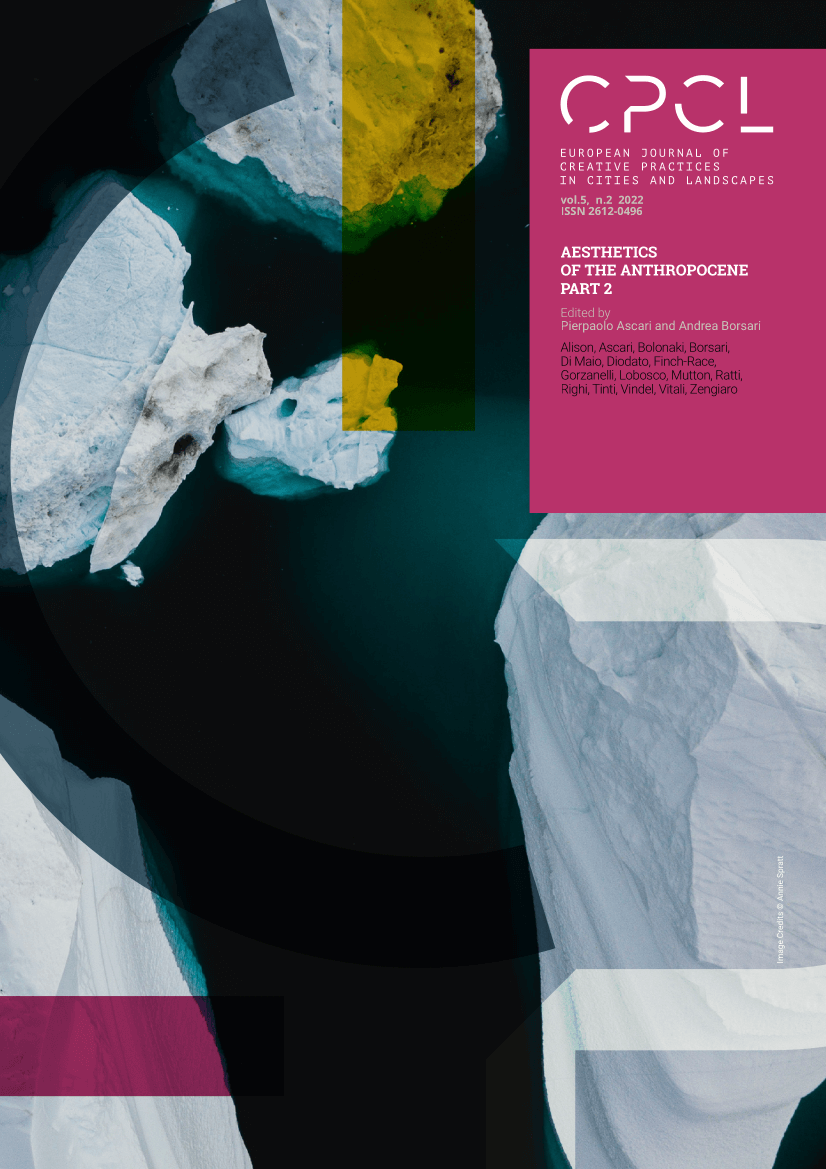On the Aesthetics of the Anthropocene: The Sublime and beyond – other Concepts and Forms of Visualizations
DOI:
https://doi.org/10.6092/issn.2612-0496/16751Keywords:
Sublime, Aesthetic Categories, Visualization, Human Epoch, DissonanceAbstract
There are many connections that link the aesthetic sphere to the set of phenomena that are encompassed by the general definition of “Anthropocene”. Among them, there are two that are explored in this contribution. On the one hand, it is a matter of getting to the bottom of the relationship between the conceptual heritage of the aesthetic-philosophical tradition and its metaphorical variants with the thematic core of the Anthropocene. On the other hand, it is a matter of ascertaining how this process intertwines and interferes with the forms of visualization of the “human epoch” and thereby conditions the possible reactions that descend from such representations. Finally, to conclude with a tentative assessment of the possibilities of countervisualization and lines of research within the conceptual field of aesthetics for a different rendering of relations with phenomena linked to the notion of the Anthropocene.
References
Baichwal, Jennifer, Nicholas de Pencier, Edward Burtynsky, Anthropocene: The Human Epoch (2018):
https://ihavenotv.com/anthropocene-the-human-epoch.
Blumenberg, Hans, Shipwreck with Spectator: Paradigm of a Metaphor for Existence (1979), trans. Steven Rendall. Cambridge: MIT Press, 1996.
Bodei, Remo, Paesaggi sublimi. Gli uomini davanti alla natura selvaggia, Milano: Bompiani, 2008.
———, Le forme del bello, Bologna: il Mulino, 2017.
Burke, Edmund, A Philosophical Enquiry into the Origin of our Ideas of the Sublime and Beautiful, London: Dodsley, 1757.
Davis, Heather and Etienne Turpin, Art & Death: Lives Between the Fifth Assessment & the Sixth Extinction, in Art in the Anthropocene. Encounters Among Aesthetics, Politics, Environments and Epistemologies, edited by Heather Davis and Etienne Turpin, London: Open Humanities Press, 2015, pp. 3-29.
Demos, T.J., Against the Anthropocene: Visual Culture and Environment Today, London: Sternberg Press, 2017.
Eagleton, Terry, The Ideology of the Aesthetic, Oxford: Basil Blackwell, 1990.
Fressoz, Jean-Baptiste, “L’Anthropocène et l’esthétique du sublime”, p. 1, in Sublime. Les tremblements du monde, Metz, Centre Pompidou-Metz, 2016, https://ressourcesplurielles.wordpress.com/2020/06/15/jean-baptiste-fressoz-lanthropocene-et-lesthetique-du-sublime-2016/.
Friedman, Thomas L., “Global Weirding is Here”, in New York Times, 17/02/2010, p. 23 (https://www.nytimes.com/2010/02/17/opinion/17friedman.html).
Horn, Eva, “Ästhetik”, in Eva Horn and Hannes Bergthaler, Anthropozän zur Einführung, Hamburg: Junius, 2019, pp. 120-142.
Latour, Bruno, Facing Gaia. Eight Lectures on the New Climatic Regime (2015), transl. Catherine Porter, London: Polity, 2017.
Lautréamont, Comte de (Isidore Lucien Ducasse), Les Chants de Maldoror, Paris: Balitout, Questroy et C.e, 1868-1869.
Lyotard, Jean-François, “The Sublime and the Avant-garde” (1984), trans. Lisa Liebmann, in Art Forum, April, 1985, pp. 36-43.
———, The Postmodern Condition: A Report on Knowledge (1979), trans. Geoffrey Bennington and Brian Massumi, Minneapolis: University of Minnesota Press, 1984.
———, “Newman: The Instant” (1985), trans. David Macey, in The Lyotard Reader, ed. Andrew Benjamin, Oxford: Basil Blackwell, 1989, pp. 240-249.
———, Lessons on the Analytic of the Sublime (1991), trans. Elizabeth Rottenberg, Stanford: Stanford University Press, 1994.
Mirzoeff, Nicholas, “Visualizing the Anthropocene”, in Public Culture, 2, April, 2014, pp. 213-232.
Mosconi, Léa and Jean-Baptiste Fressoz “L’Anthropocène chez les architectes d’aujourd’hui”, in L’art Même, 78, 2019, pp. 7-9.
Turpin, Etienne, ed., Architecture in the Anthropocene: Encounters Among Design, Deep Time, Science and Philosophy, edited by London: Open Humanity Press, 2014.
Downloads
Published
How to Cite
Issue
Section
License
Copyright (c) 2022 Andrea Borsari

This work is licensed under a Creative Commons Attribution 4.0 International License.




